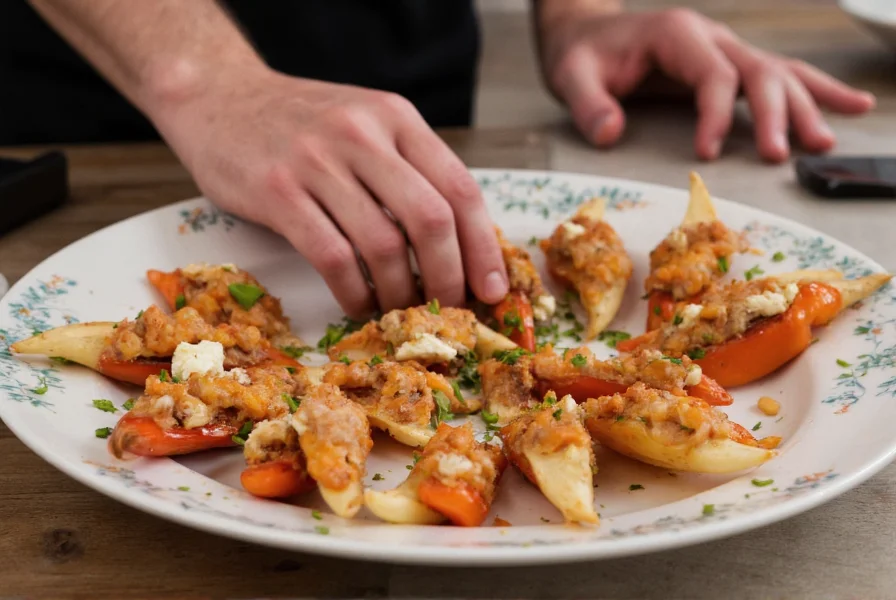Piquillo peppers are small, triangular-shaped red peppers originating from Spain, specifically the Navarra region. These distinctive peppers are roasted over an open flame, giving them a sweet, smoky flavor with mild heat (500-1,000 Scoville units). Unlike regular bell peppers, piquillo peppers have a unique tapered shape and are traditionally preserved in jars after roasting, making them a staple in Spanish cuisine.
When exploring Spanish culinary ingredients, few specialty peppers capture attention like the piquillo. These vibrant red peppers have gained international recognition for their exceptional flavor profile and versatility in cooking. Understanding what makes piquillo peppers special requires examining their distinctive characteristics, traditional preparation methods, and culinary applications that set them apart from other roasted peppers.
Distinctive Characteristics of Piquillo Peppers
What truly defines piquillo peppers is their unique combination of physical attributes and flavor notes. These peppers measure approximately 3-4 inches in length with a distinctive triangular shape that tapers to a point—"piquillo" actually translates to "little beak" in Spanish, referencing this characteristic shape.
Their flavor profile represents a perfect balance between sweetness and subtle heat. Unlike jalapeños or other hotter varieties, piquillo peppers register between 500-1,000 Scoville heat units, placing them in the mild category. This makes them accessible to those who prefer less spicy foods while still providing that characteristic pepper complexity.

Traditional Production Process
The authentic preparation method significantly contributes to piquillo peppers' unique qualities. Traditional production involves:
- Hand-picking at peak ripeness when the peppers turn deep red
- Roasting over open beechwood flames, which chars the skin and enhances flavor
- Manual peeling to remove the charred skin while preserving the delicate flesh
- Packing in jars, often with a light brine or olive oil
This flame-roasting technique creates the signature smoky-sweet flavor that distinguishes authentic piquillo peppers from other roasted red peppers that might be roasted using gas ovens or other methods.
Piquillo Peppers vs. Similar Varieties
Understanding how piquillo peppers differ from similar options helps home cooks make informed choices. The following comparison highlights key differences:
| Pepper Type | Shape | Heat Level | Flavor Profile | Common Preparation |
|---|---|---|---|---|
| Piquillo | Triangular, tapered | Mild (500-1,000 SHU) | Sweet, smoky, complex | Flame-roasted, jarred |
| Roasted Red Bell | Bell-shaped | None | Sweet, less complex | Oven-roasted, jarred |
| Ñora | Round, flat | Mild | Earthy, dried fruit notes | Dried, rehydrated |
| Padrón | Long, slender | Variable (mostly mild) | Grassy, occasionally hot | Fresh, pan-fried |
Culinary Applications of Piquillo Peppers
Professional chefs and home cooks value piquillo peppers for their versatility in Spanish and international cuisine. Traditional Spanish dishes featuring piquillo peppers include:
- Pimientos rellenos - Stuffed with cod, cheese, or meat
- Salmorejo - Enhanced version of the classic tomato soup
- Tapas presentations - Often served with anchovies or goat cheese
- Sauces and spreads - Blended into romesco or aioli variations
Modern culinary applications extend beyond traditional Spanish cooking. Chefs incorporate piquillo peppers into:
- Empanada fillings for added sweetness and color
- Seafood dishes as a flavor complement to fish and shellfish
- Vegetable tarts and quiches for visual appeal and flavor
- Marinades for poultry and pork

Storage and Substitution Options
Proper storage maintains the quality of piquillo peppers. Unopened jars can be stored in a cool, dark pantry for 1-2 years. Once opened, transfer remaining peppers to an airtight container and cover with olive oil, then refrigerate for up to 2 weeks.
When authentic piquillo peppers aren't available, consider these substitution options:
- Best substitute: Roasted red peppers with a touch of smoked paprika to mimic the smoky flavor
- For stuffing applications: Small roasted bell peppers cut into triangular shapes
- For intense smokiness: A combination of roasted red peppers and a pinch of chipotle powder
When selecting piquillo peppers, look for products labeled "Pimientos del Piquillo de Lodosa," which indicates they come from the protected geographical indication region in Navarra, Spain—guaranteeing authentic production methods.
Nutritional Benefits of Piquillo Peppers
Beyond their culinary appeal, piquillo peppers offer notable nutritional advantages. A 100g serving typically contains:
- Nearly 200% of the daily recommended intake of vitamin C
- Significant amounts of vitamin B6 and potassium
- Only about 25 calories per serving
- Rich in antioxidants including carotenoids and capsaicinoids
The roasting process actually enhances certain nutritional aspects by making carotenoids more bioavailable while preserving most vitamin content. These nutritional properties make piquillo peppers not just flavorful but also a healthy addition to various dishes.











 浙公网安备
33010002000092号
浙公网安备
33010002000092号 浙B2-20120091-4
浙B2-20120091-4